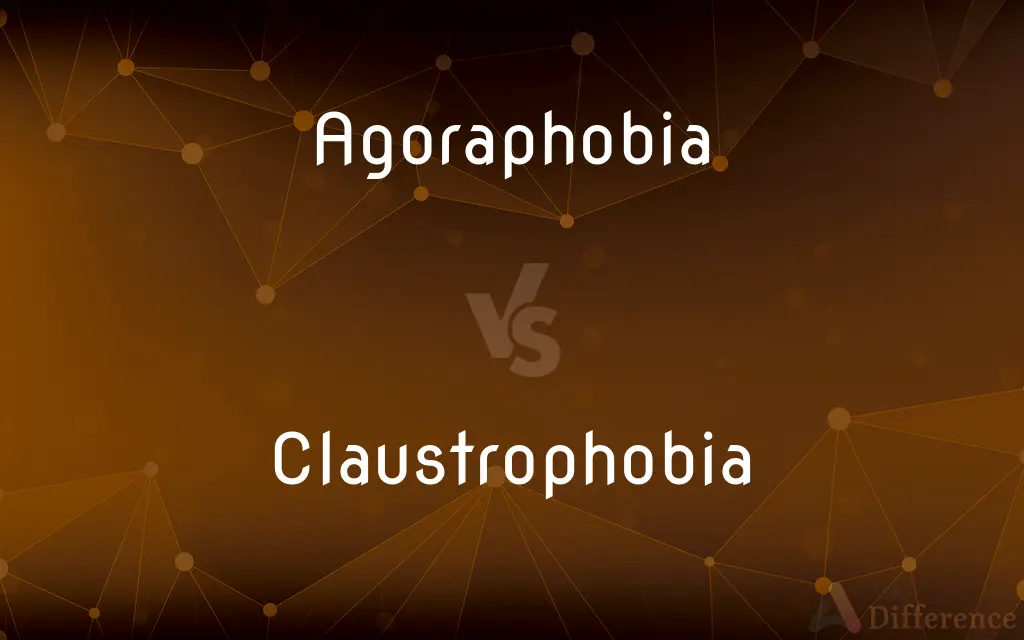Agoraphobia vs. Claustrophobia — What's the Difference?
Edited by Tayyaba Rehman — By Fiza Rafique — Updated on November 2, 2023
Agoraphobia is fear of open or public spaces; claustrophobia is fear of tight or enclosed spaces.

Difference Between Agoraphobia and Claustrophobia
Table of Contents
ADVERTISEMENT
Key Differences
Agoraphobia is a condition where individuals feel extreme panic in places that are difficult to escape or where help might not be available. It is often a misunderstood phobia, not just fear of open spaces but fear of being trapped in situations where escape is not readily accessible. On the other hand, claustrophobia is characterized by an irrational fear of being enclosed. Claustrophobics may panic in elevators or small rooms without open windows.
Individuals with agoraphobia may avoid public transport, large open spaces, or any place where crowds gather. The central element is the fear of a lack of control or being far from a personal safe zone. Claustrophobia, in contrast, triggers anxiety in environments with limited space and the perceived lack of oxygen, causing a claustrophobic person to dread situations like being in a crowded elevator.
Agoraphobia can lead to a dependence on a safe person or safe area, restricting the individual's ability to function normally in society. Claustrophobia, however, often results in avoidance of situations like flying or being in a windowless room, limiting an individual's activities based on the potential for confinement.
Treatment for agoraphobia may involve exposure therapy, where the individual is gradually exposed to more challenging environments under controlled conditions. Similarly, claustrophobia can also be treated with exposure therapy, but the focus is on small, closed spaces rather than open or public places.
Both agoraphobia and claustrophobia can significantly impair one’s quality of life, but they differ in the nature of the fear and the types of situations that trigger panic. Understanding these differences is crucial for appropriate diagnosis and treatment.
ADVERTISEMENT
Comparison Chart
Trigger
Open spaces, crowds, feeling trapped.
Enclosed spaces, feeling suffocated.
Fear of
Being unable to escape or get help.
Confined spaces and the lack of an exit.
Common Situations
Public transport, open markets, large malls.
Elevators, small rooms, tunnels.
Symptoms
Anxiety in open or public spaces.
Anxiety in tight or confined spaces.
Treatment Focus
Exposure to wide, open or public spaces.
Exposure to small or enclosed spaces.
Compare with Definitions
Agoraphobia
Agoraphobia is a fear of being in situations where escape might be difficult.
She didn't attend the concert due to her agoraphobia.
Claustrophobia
Claustrophobia is the fear of being restricted or confined in a small area.
She felt her claustrophobia kick in during the MRI.
Agoraphobia
Agoraphobia is anxiety about being in places where help may not be available.
Agoraphobia keeps him from traveling far from home.
Claustrophobia
Claustrophobia is an anxiety disorder characterized by a fear of enclosed spaces.
He took the stairs to avoid his claustrophobia in the elevator.
Agoraphobia
Agoraphobia is a fear of open spaces.
The vastness of the empty field triggered her agoraphobia.
Claustrophobia
Claustrophobia is a fear of having no escape and being closed in small spaces.
Claustrophobia made her hesitant to enter the crowded room.
Agoraphobia
Agoraphobia is the avoidance of situations that might cause panic.
Agoraphobia caused her to refuse the invitation to the festival.
Claustrophobia
Claustrophobia is an irrational fear of places with no easy exit.
His claustrophobia prevented him from using the underground subway.
Agoraphobia
Agoraphobia is the fear of public spaces.
Because of her agoraphobia, she avoids shopping malls.
Claustrophobia
Claustrophobia is discomfort or distress caused by being in tight spaces.
Claustrophobia is why she prefers seats near the theater exits.
Agoraphobia
Agoraphobia is a mental and behavioral disorder, specifically an anxiety disorder characterized by symptoms of anxiety in situations where the person perceives their environment to be unsafe with no easy way to escape. These situations can include open spaces, public transit, shopping centers, or simply being outside their home.
Claustrophobia
Claustrophobia is the fear of confined spaces. It can be triggered by many situations or stimuli, including elevators, especially when crowded to capacity, windowless rooms, and hotel rooms with closed doors and sealed windows.
Agoraphobia
Extreme or irrational fear of entering open or crowded places, of leaving one's own home, or of being in places from which escape is difficult.
Claustrophobia
Extreme or irrational fear of confined places
The small stuffy room had begun to give him claustrophobia
Agoraphobia
An anxiety disorder characterized by intense fear or anxiety about being in open or public places.
Claustrophobia
Fear of being in narrow or enclosed spaces.
Agoraphobia
The fear of wide open spaces, crowds, or uncontrolled social conditions.
Claustrophobia
The fear of closed, tight places.
Agoraphobia
(rare) An aversion to markets.
Claustrophobia
A morbid fear of being closed in a confined space
Agoraphobia
A morbid fear of open spaces (as fear of being caught alone in some public place)
Common Curiosities
Can children have agoraphobia?
Yes, children can develop agoraphobia, though it is more commonly diagnosed in adults.
What causes agoraphobia?
Agoraphobia can be caused by a combination of genetic, psychological, and environmental factors.
Does agoraphobia affect daily life?
Yes, agoraphobia can severely restrict one's lifestyle, impacting daily routines and social interactions.
How common is claustrophobia?
Claustrophobia is relatively common, with varying degrees of severity.
What are typical symptoms of claustrophobia?
Symptoms include sweating, shaking, and fear of losing control when in a confined space.
Is agoraphobia linked to other anxiety disorders?
Yes, agoraphobia can be associated with other anxiety disorders and panic disorder.
Can claustrophobia happen suddenly?
Yes, claustrophobia can occur suddenly, often triggered by a specific incident.
Is agoraphobia just a fear of open spaces?
No, agoraphobia includes fears of situations where escape might be difficult or help unavailable.
Does claustrophobia only occur in elevators and airplanes?
No, claustrophobia can occur in any confined space or situation where someone feels trapped.
Are panic attacks a symptom of claustrophobia?
Yes, panic attacks can be a common symptom when a claustrophobic person is in a confined space.
Is there a cure for agoraphobia?
While there's no guaranteed cure, many treatments like therapy and medication can manage agoraphobia effectively.
Can claustrophobia be treated with medication?
Medication can help manage symptoms but is usually used alongside therapy.
Can agoraphobia be self-diagnosed?
Self-diagnosis is not recommended; professional diagnosis is important for accurate identification and treatment.
Do people with claustrophobia avoid all small spaces?
Not all, but they may avoid spaces that trigger their anxiety, which can vary from person to person.
Is exposure therapy effective for both agoraphobia and claustrophobia?
Yes, exposure therapy is a common and effective treatment for both conditions when conducted by a professional.
Share Your Discovery

Previous Comparison
Tanktop vs. Vest
Next Comparison
Sinker vs. CutterAuthor Spotlight
Written by
Fiza RafiqueFiza Rafique is a skilled content writer at AskDifference.com, where she meticulously refines and enhances written pieces. Drawing from her vast editorial expertise, Fiza ensures clarity, accuracy, and precision in every article. Passionate about language, she continually seeks to elevate the quality of content for readers worldwide.
Edited by
Tayyaba RehmanTayyaba Rehman is a distinguished writer, currently serving as a primary contributor to askdifference.com. As a researcher in semantics and etymology, Tayyaba's passion for the complexity of languages and their distinctions has found a perfect home on the platform. Tayyaba delves into the intricacies of language, distinguishing between commonly confused words and phrases, thereby providing clarity for readers worldwide.
















































